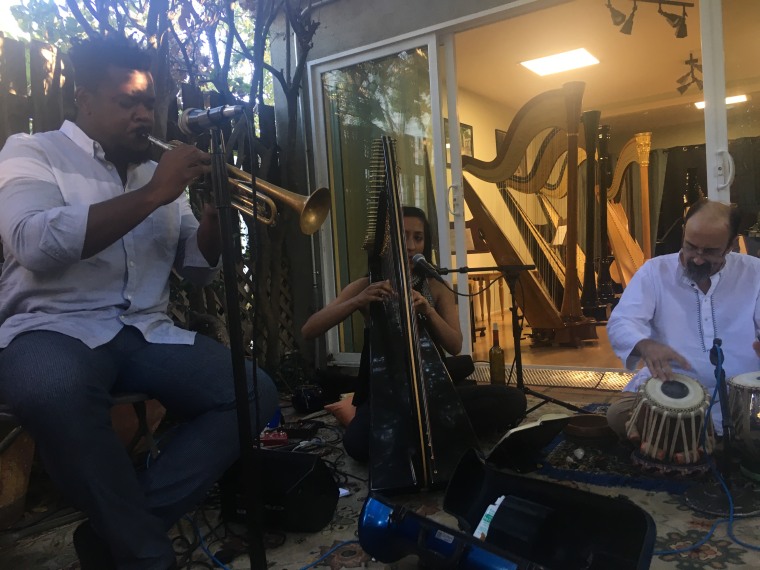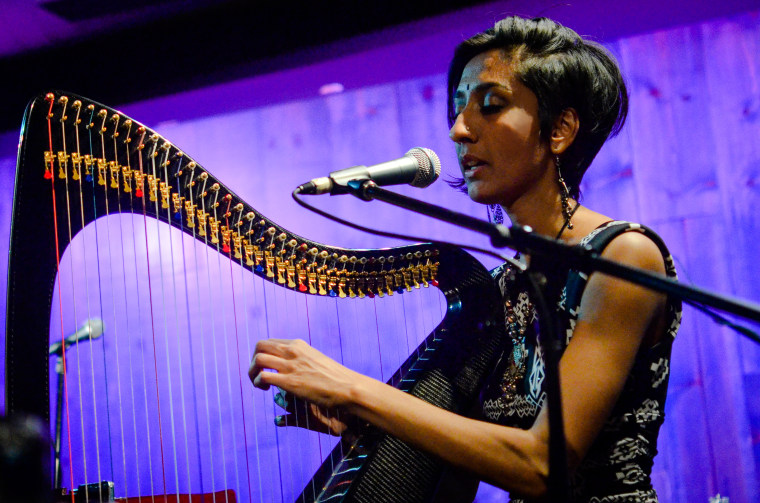PASADENA, Calif. — At an autumn concert in Southern California, instrumentalist and vocalist Sheela Bringi carefully adjusted the strings of her harp before dedicating the opening invocation to Goddess Sarasvati, the Hindu deity of music and learning.
The goddess is particularly important to her because the two share a similar instrument.
“The stringed instrument that she plays when you see her depicted in a painting or statue is called the "veena," and what’s special to me is that the veena, in its ancient form, was actually a harp,” Bringi said.
“Being Indian and American, and a musician, I try to put the two things together. I try to build something new without losing contact to the traditional source. It might fall down, but for me, it’s important to try.”
The stringed instrument first came into her life when her godmother gifted one when Bringi was 14. She said she knew then that the harp had the ability to enchant people and bring them together.
A Hindustani classical and devotional musician, the 33-year-old incorporates influences from American blues and jazz with the classical Indian music she learned as a child from her parents and classically trained musicians in India.
In 2014, Bringi released her debut album, “Incantations,” and in 2016, she released her second album, “Shakti Sutra,” a mix of ancient Indian mantras and ragas with soulful rhythms, both produced by longtime friend and collaborator Clinton Patterson.
Her music features devotional songs and tributes to fierce warrior Hindu goddesses with a focus on the mystical, she said. Themes explored include the triumph of light over darkness, the nature of reality and the mind, and the mystical nature of creativity and transcendence, Bringi said.
In addition to the harp, she plays several instruments, among them the piano, the bansuri (an Indian bamboo flute), and the harmonium.
Bringi grew up in a “musical household” in Fort Collins, Colorado, and her parents — both scientists who immigrated to the U.S. in the early ‘70s — also trained in classical Indian music and encouraged her to explore the arts.
Music was a refuge growing up, Bringi said, helping her connect to her ancestral roots and take others on a journey of self-discovery.
At the time, there were few Indian families in Fort Collins, she recalled, and performing was a large part of social gatherings and family reunions. Music also helped her feel at ease and comfortable in her own skin and helped her better embrace her identity as an Indian-American woman and daughter of immigrants.
“I think part of the reason I threw myself into music when I was young was because it was a very difficult environment to grow up in when you’re the only person of color in school,” she said. “There was a lot of ignorance and racism, and being made fun of by other kids.”

Her mom, who was her first instructor, taught her many of the traditional devotional songs (called bhajans) she still sings today. Bringi’s earliest training was in carnatic music — a South Indian classical style — and Sanskrit mantra chanting, she said. She began vocal and piano lessons at the age of 5.
As a young woman, she trained in Hindustani classical music from North India under the instruction of Pandit G.S Sachdev and Ustad Aashish Khan, both classically trained musicians. She continues to study the style with Sri Subhashish Mukhopadyay, a voice teacher.
Bringi said that while she trained in traditional Indian music, she also grew up heavily influenced by popular music and jazz and was determined to find a way to bring the different genres together.
As a teenager, Bringi found musical inspiration listening to Asian Underground, a British and Canadian blend of dance music with the styles of South Asia. Other influences include singer-songwriter M.I.A., Norah Jones, sitar maestro Ravi Shankar, and jazz trumpeters Miles Davis and Jon Hassell.
She became interested in jazz when she saw a piano player perform at a friend’s wedding as a teenager.
“I loved the spontaneity and passion with which he was playing and the way that he was improvising and singing along while he played,” Bringi said. “I fell in love with it, and I wanted to learn how to improvise like him with so much feeling.”
Bringi said that having this exposure to these two traditions has allowed her to collaborate with many people and speak music in “two languages.”
“I think part of the reason I threw myself into music when I was young was because it was a very difficult environment to grow up in when you’re the only person of color in school.”
For the past several years, she’s been working on the “Hindustani Harp Project,” a series of approaches to playing Indian “ragas,” which are similar to keys in Western music, on the harp.
The goal is to bridge worlds with her work and explore the connections between her ancestral homeland and the West, Bringi said.
“When I play music, I hope I am taking people on a journey with me and that I'm able to transport people into a different kind of world," she said.
“Being Indian and American, and a musician, I try to put the two things together," she later added. "I try to build something new without losing contact to the traditional source. It might fall down, but for me, it’s important to try.”
Follow NBC Asian America on Facebook, Twitter, Instagram and Tumblr.
